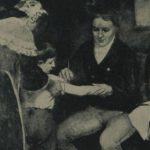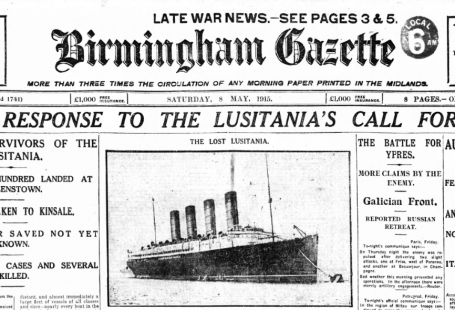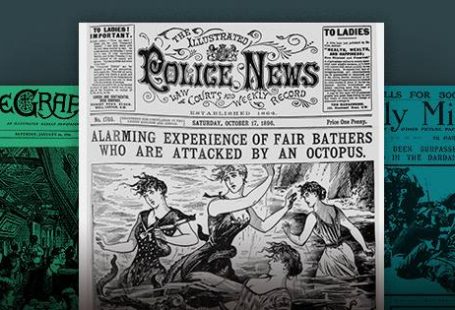Our familiar Christmas customs – decorating our houses with holly and ivy, enjoying chocolate yule logs and giving presents – have, for the most part, their origins in ancient pagan practices. In this special blog, using articles taken from the rich pages of the British Newspaper Archive, we take a look at how our Christmas traditions have evolved through time, with Druid, Roman and Norse influences.
Want to learn more? Register now and explore The Archive
From Saturnalia to The Lord of Misrule
Chief amongst the precursors for Christmas was Saturnalia, a festival observed in Roman times. Held ‘towards the end of December…Saturnalia fell at the completion of the agricultural labour of the year and consequently every business was interrupted.’ Saturnalia was famed for the ‘complete social reversal’ that it permitted, with the rigid distinctions between masters and slaves expunged for the duration of the festival.
Saturnalia | Britannia and Eve | 1 December 1932
This notion of social reversal is something that carried into early English Christmas celebrations. Mummers celebrating Christmas in the north of England, according to an 1830 piece in The Atlas, would change ‘clothes between the men and the women.’ Once they were ‘dressed in each other’s habits’ they would ‘go from one neighbour’s house to another, and partake of their Christmas cheer, and make merry with them in disguise, by dancing and singing, and such like merriments.’
‘Every thing was out of nature and propriety’ | The Atlas | 3 January 1830
And this clear disruption of social norms perhaps influenced the establishment of the position of the Lord of Misrule in Medieval and Tudor times. Chronicler Raphael Holinshed describes how, at Christmastime, ‘there is is alwayes one appointed to make sporte at courte called commonly lorde of misrule.’ Sometimes a person belonging to the lower classes, the Lord of Misrule’s job was to oversee and facilitate wild revelries and drunkenness.
And whilst the idea of social reversal has long since died out from our celebrations of Christmas, another preserve of Saturnalia remains – presents. As Britannia and Eve relates, ‘During Saturnalia, it was the tradition and convention for friends to exchange gifts.’
The Everlasting Appeal of Evergreens
The holly and the ivy are also of course synonymous with Christmas, appearing in songs across the years and as decorations in homes across the country. But for thousands of years such evergreen plants have been thought to ‘give protection against evil.’
Bringing Home the Evergreens | Illustrated London News | 8 November 1957
The Illustrated London News reveals how ‘The decorations of churches, houses, and shops on festive occasions dates from a period long before Christ.’ But Christians soon imbued the evergreen with their own symbolism, as this account from the sixteenth century reveals:
Our churches and houses, decked with bayes and rosemary, holly and ivy, and other plants which are always green, winter and summer, signify and put us in mind of His Deity, that the Child that now was born with God and man, who should spring up like a tender plant, should always be green and flourishing, and live for evermore.
The evergreen retained its popularity as a symbol of Christmas well into the twentieth century. As a 1906 article in The Graphic relates, ‘there is an increasing demand each year for foliage for decorations.’ This demand was met by holly growers from Surrey:
All along the South Western line, where it runs through Surrey, especially round the district of Woking, numberless small lots of evergreens are carted to the station and loaded on the trucks, being brought up direct to Nine Elms Goods Station, where they are sold by auction to greengrocers and costermongers for retailing to householders.
The Graphic | 15 December 1906
Mistletoe and Holly – A Time Honoured Custom
Mistletoe, ‘an object of our national veneration,’ is another plant that is rich in ancient symbolism. The Sphere, 1903, tells of how ‘Druids used to cut the mistletoe from their sacred oaks with elaborated ceremony’ using a golden knife. Such a ceremony saw two white bulls sacrificed, accompanied by music and processions. Across Europe, it was believed that mistletoe could repel witches.
December Lanes | Illustrated London News | 25 December 1954
Like mistletoe, holly was also thought to repel witches. Unlike mistletoe, however, which manages to retain something of its association with paganism, holly was strongly imbued with Christian symbolism:
Holly, often called ‘Christmas’ or ‘Christ’s Thorn,’ stood for life in death. On the day of the birth of Christ its prickly leaves symbolised the Crown of Thorns and its red berries the drops of Christ’s blood.
And superstitions soon arose around the prickly plant:
The good folk of Rutland are said never to bring holly into a house before Christmas Eve, believing to do so would ensure them a year’s yield of bad luck. The country people in Derbyshire are also credited with believing that the roughness or smoothness of the holly that comes into a house at Christmas determines whether the husband or the wife will be master for the ensuing year.
They Drew the Yule Log in From the Frosty Night
Nowadays, the yule log is primarily of a chocolate variety enjoyed over the Christmas period. But in the Middle Ages, it was a very real large log of wood that formed a focal point of Christmas celebrations.
The Feudal Christmas – Bringing in the Yule Log | The Sphere | 17 November 1949
The Sphere tells us that throughout the Middle Ages, ‘every farmhouse, cottage and castle in England burnt its yule log upon the hearth.’ And again, the yule log has its origins in pagan practices. The word ‘yule,’ again according to The Sphere, stems from the Anglo-Saxon ‘Geol,’ which means December.
Norsmen, believing in the twelve nights between December 25 and January 6 that they could trace their god Odin in the night’s sky, would hold a mighty feast, burning a yule log as they did so to illuminate his journey
Viand Royal – The Boar’s Head
One ancient tradition has all but died out, however, that of the boar’s head. ‘Ranked even before the Turkey and the Sirloin in the esteem of the English hosts and guests,’ according to the Illustrated London News, the boar’s head was introduced by the Norman conquerors to English Christmas traditions.
Illustrated London News | 2 November 1971
In 1956 Eric Bennet in The Tatler relates how the first course of any Christmas meal was Viand Royal – the boar’s head, ‘served with hot spiced gravy and brawn with a tart sauce.’ However, the lack of boars in the United Kingdom eventually led to this tradition dying out – but it is still a feature of the Boar’s Head Gaudy feast held at Queen’s College, Oxford.
Thus, some ancient Christmas customs have fallen along the wayside over time, but we still continue to celebrate the festival with practices which are thousands of years old – and all of this can be traced through the illuminating pages of the British Newspaper Archive.














